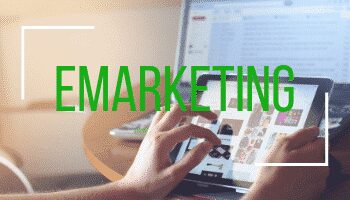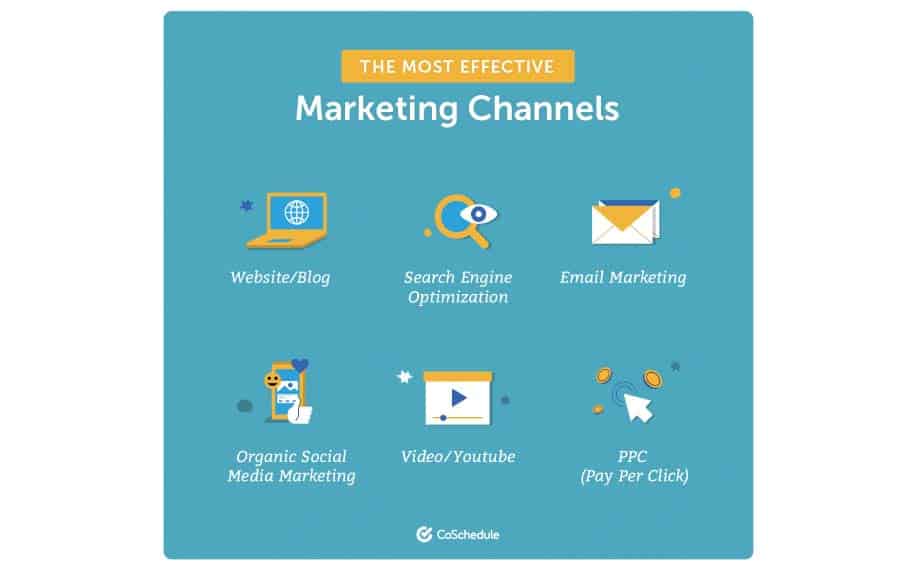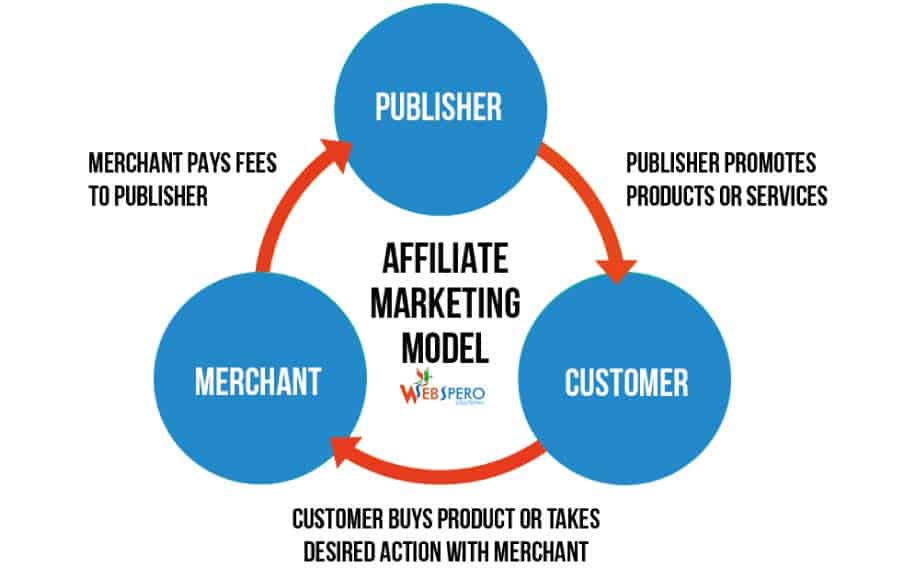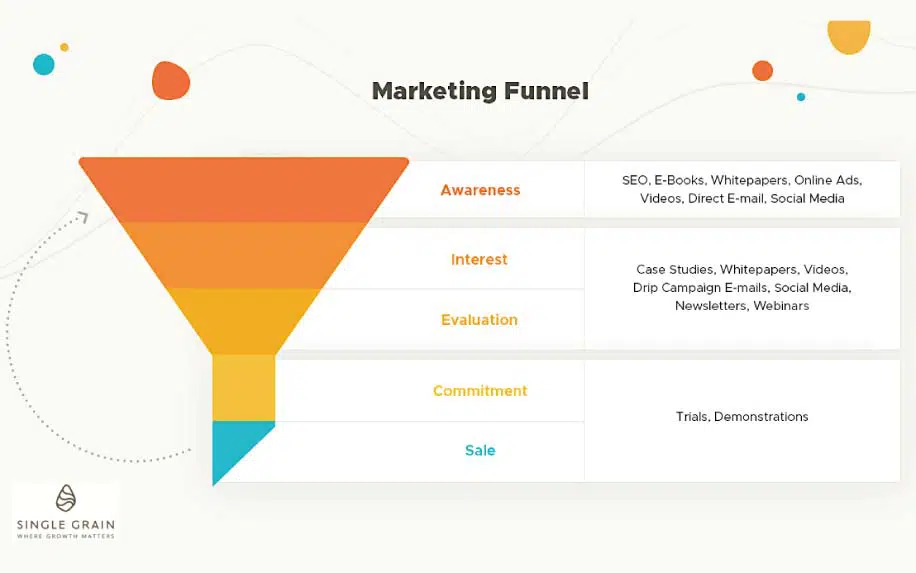
Business has come a long way. Today, marketing isn’t bound to brick-and-mortar institutions. It revolves around modern communication, mobile technology and evolving principles. In the online world, it’s all about Emarketing.
Of course, most businesses know this.
What they don’t know is how they can use it to their advantage. The reality is that eMarketing has democratised the market. Now, even the smallest businesses can compete with major international brands.
Today, we’re going to look at everything you need to know. Let’s start with the basics.

What is eMarketing Exactly?
eMarketing is a rapidly growing field, and businesses of all sizes use it to reach their target audience and achieve their business goals. eMarketing offers several benefits, including:
- Cost-effectiveness: eMarketing is a relatively cost-effective way to reach many people.
- Measurability: eMarketing campaigns can be tracked and measured so you can see what is working and what is not.
- Targeting: eMarketing allows you to target your marketing messages to specific audiences.
- Personalization: eMarketing allows you to personalize your marketing messages to individual customers.
The definition of eMarketing hasn’t changed much since it was established. eMarketing is any of the wide-ranging strategies used to offer goods and services online. Often, business operators who embrace digital marketing also leverage eMarketing strategies.
The two are incredibly similar, but eMarketing removes the ‘online’ portion from the mix. It doesn’t require typical online promotions to influence sales, connect with customers and promote products.
eMarketing is more focused on customer relationships. So, rather than putting the technology first, it is all about leveraging new technologies to create amazing customer experiences.
Benefits of eMarketing:
EMarketing offers several benefits for businesses of all sizes, including:
- Increased brand awareness: eMarketing can help you increase brand awareness by getting your name and message in front of more people.
- eMarketing can help you generate more leads and sales by attracting potential customers to your website and landing pages.
- Improved customer engagement: eMarketing can help you improve customer engagement by providing valuable content and interacting with them on social media.
- Reduced costs: eMarketing can help you reduce your marketing costs by automating tasks and targeting your marketing messages to specific audiences.
The Many Forms of eMarketing
To understand eMarketing, one must understand how it’s been responsible for developing innovations. In modern business, eMarketing is an essential component of the marketing mix.
Modern companies continuously allocate resources, driving them via eMarketing solutions and directing customers towards new options. Here are some of the most common eMarketing channels.

Email Delivery Services
Email marketing is one of the oldest eMarketing techniques around. Whether clients need updates, product information or service options, email marketing can help.
Email marketing tells buyers about future products in monthly newsletters and connects brands directly with consumers. Today, most people access their email on mobile.
The following innovations have made mobile-based email marketing more profitable:
- Short-code,
- Digital coupons,
- Website links,
- Location-based services.
Social Media Marketing
Social media marketing, while still growing, has a firm foundation in the eMarketing world. It’s the perfect accessory for any digital marketing campaign, and it’s responsible for most online information retrieval resources.
Today’s online communities are sharing links, promoting brands, watching videos, and engaging the buying world with incredible speed.
Because social media networks like Facebook, Twitter, and Instagram are incredibly large, community managers, advertisers, and business leaders are working hard to offer substantial business opportunities to buyers.
Search Marketing Services
Pay-per-click, or PPC, marketing is one of the fastest avenues to garner sales, increase online visibility and advertise a website. The Internet is where people turn when they need just about anything.
To promote products and services correctly, a business must adopt PPC advertising strategies.
Successful PPC campaigns increase a business’s ROI and—in some cases—can immediately spike consumer traffic.
Because the end game of PPC strategies is to drive sales, business operators are crafting sophisticated campaigns centric on targeting conversion as an asset. A lot of PPC activity helps make consumer information transparent.
It reports search metrics back to the business, revealing information about:
- Website clickthrough,
- Page views,
- Shopping cart abandonment rates,
- Customer behaviours and trends.
Affiliate Marketing Programs
Affiliate marketing, meanwhile, helps online businesses grow via a partnership. It’s considered one of online advertising’s ‘purest’ forms. Because it revolves around transactions, affiliate marketing relies on commission-based services.
In other words, with affiliate marketing, you offer to give independent marketers a cut of each sale you make.
As long as this cut doesn’t eat into your profit margin, everybody wins.

Search Engine Optimisation
You’ve probably heard about the importance of organic traffic. Search engine optimization, or SEO, naturally increases a website’s traffic by making sure its sitemaps, content, links and coding are presented in a digestible way.
This is the cornerstone of any effective marketing strategy, as it is the most sustainable and cost-effective way to get traffic to your website in the long term.
Display Marketing
Display marketing has come a long way. Often called CPM advertising, display marketing campaigns increase brand awareness, boost website traffic, increase sales and boost product leads. In the past, display marketing was bound to banner advertisements.
Now, it’s being incorporated into mobile technology, virtual reality apps and augmented reality services.
Display marketing, while more classic than many eMarketing approaches, is still responsible for inventory placement, inventory management, campaign optimization and tracking options.
Comparison of Core eMarketing Types:
| Type | Best For | Pros | Cons |
|---|---|---|---|
| Email Marketing | Promotions, engagement with contacts | Inexpensive, highly targeted, measurable | Potential spam perception, low open rates |
| Search Marketing | Generating traffic, conversions | Reaches users at precise intent stage | Slow organic SEO results, high PPC costs |
| Social Media Marketing | Brand awareness, lead generation | Massive reach, viral sharing | Platform algorithm changes, low conversion rates |
| Content Marketing | Organic reach, lead nurturing | Builds credibility and trust | Requires substantial resources |
| Affiliate Marketing | Cost-efficient sales | Only pay for performance | Loss of control over brand messaging |
How to choose an eMarketing agency:
When choosing an eMarketing agency, it is important to consider the following factors:
- Experience: Ensure the agency has experience working with businesses in your industry.
- Services: Make sure that the agency offers the services that you need.
- Budget: Make sure that the agency’s fees fit your budget.
- Reputation: Ensure the agency has a good reputation and that its clients are happy with its services.
How Has eMarketing Changed and Evolved?
Of course, like any other form of marketing, eMarketing is constantly changing to respond to new strategies, consumer behaviour and technology. Here are some key ways the eMarketing has pivoted in recent years.
Funnel Marketing
The question, “What is eMarketing?” is changing itself. In the past, display advertisements were king. Now, lead generation is a go-to strategy for many companies.
Lead generation tools, implemented across company websites, help consumers access mailing lists, read newsletters and redeem coupons. While lead generation is about traffic generation, it’s become the crux of modern digital business.
As more and more companies get better at marketing online, the number of user interactions needed to make a sale has also increased. This means getting new users into a marketing funnel rather than trying to make a sale straight away.
Response collection tools, first and foremost, are leading the way. These tools aren’t online polls and feedback forms, either.
They’re digital footprint trackers. It isn’t enough to find out what a customer’s favourite product is. Businesses must focus on related products, favoured services and effective advertising methods.
Lead magnets also convince potential customers to sign up for your mailing list.

Social Media Content and Cross-Channel Marketing
Above, we discussed the importance of Facebook, Twitter, and Instagram as marketing tools. It’s worth mentioning their ability to promote cross-channel travel. Digital advertising tools, like Facebook Ads and Google Adwords, target specific customer demographics.
For example, if a company utilizes Google AdWords to promote text advertisements, users will likely encounter them via their Facebook Newsfeed.
Why? Because social media itself has become a marketing platform.
Today’s companies are promoting via 360-degree media, music video campaigns and YouTube affiliate advertisements. Text, too, is popular. If a business can promote an affiliate’s blog or eZine, they’re headed in the right direction.
To gain customers, you need to understand customer niches. A lot of modern advertisement revolves around inviting buyers to email lists, promoting coupons and utilizing instant access as a door-opener.
The Power of Mobile Marketing
Because of this immediate access, business providers have turned to smartphones. Today, 55% of email is opened via mobile.
Mobile access isn’t simply a marketing amenity. It’s the future of real-time eCommerce, the foundation of modern eMarketing and the future of business innovation.
Today’s industries are flocking to mobile—and it isn’t a surprise. When customers can engage fully, with immediate access and on a rolling basis, the business has incredible visibility.
eMarketing is incredibly durable, too. We’re in the information age, and our access to technology isn’t going anywhere.
Likely, the future will present more opportunities via virtual reality display ads, quick-access mobile deals and highly immersive social media. As the customer’s demand for here-and-now products increases—so, too, does the world of electronic marketing.
Key eMarketing Tools and Platforms
Email Marketing Tools: Mailchimp, Constant Contact, AWeber, GetResponse
SEO Tools: Ahrefs, SEMRush, Moz, Screaming Frog
PPC Platforms: Google Ads, Microsoft Ads, Facebook Ads
Social Media Tools: Sprout Social, Hootsuite, Buffer, Rival IQ
Analytics Platforms: Google Analytics, Adobe Analytics, Mixpanel, Heap
CRM Software: Salesforce, HubSpot, Zoho CRM, Pipedrive
Landing Page Builders: Unbounce, LeadPages, ClickFunnels, Instapage
Best Practices for eMarketing Success:
- Focus on the buyer’s journey – Map out key stages and customize strategy for each.
- Integrate campaigns across channels – Align messaging and transitions between email, social, content etc.
- Mobile optimization – Design all assets and landing pages for mobile responsiveness.
- Quality over quantity – Build genuine connections with engaged followers over vanity metrics.
- Prioritize conversion optimization – Continually test and optimize landing pages, CTAs, forms etc. to maximize conversions.
- Monitor performance closely – Track detailed metrics and KPIs to identify optimization opportunities.
- Account-based approaches – Develop hyper-targeted campaigns focused on high-value accounts.
- Automation and personalization – Leverage tools to scale one-to-one messaging tailored to individuals.
- Ongoing testing – Continually test content formats, offers, segments and campaigns.
- Focus on lifetime value – Optimize for customer lifetime value over single transactions.
The wide range of eMarketing tools and strategies enables brands to engage customers across channels and attract qualified traffic. By following best practices and leveraging the strengths of each eMarketing category, marketers can drive growth successfully.
FAQ:
What are the different types of eMarketing?
There are many different types of eMarketing, including search engine optimization (SEO), content marketing, social media marketing, paid advertising, and email marketing.
How can eMarketing help my business?
eMarketing can help your business by increasing brand awareness, generating leads, and driving sales.
How much does eMarketing cost?
The cost of eMarketing varies depending on the type of services you need and the size of your business. However, there are a variety of affordable eMarketing services available for businesses of all sizes.
What are the most important eMarketing strategies?
The core foundations of a strong eMarketing strategy are email marketing, search engine optimization, pay-per-click ads, social media marketing, and content creation. Most companies should focus on mastering these before exploring more advanced tactics.
What skills are required to succeed at eMarketing?
eMarketing requires creative skills for content development, analytical skills to derive insights, and technical skills to manage campaigns and tools. Having strengths across all three is ideal.
What does a typical eMarketing budget look like?
Most small companies budget $2,500 to $5,000 monthly for eMarketing activities. Mid-size and enterprise companies may spend over $10,000 to $25,000 monthly on eMarketing.
How long does it take to see results from eMarketing efforts?
Lead generation and brand-building efforts can take 3-6 months to start producing tangible results. SEO visibility takes even longer. Give campaigns time to optimize before judging effectiveness.
How do you track eMarketing performance?
Web analytics tools like Google Analytics are essential for tracking key eMarketing metrics like traffic volume, lead conversions, click-through rate, cost per acquisition, and return on ad spend.
Should I hire an in-house eMarketing expert or agency?
For most businesses, it makes sense to work with an eMarketing agency initially. As eMarketing needs to scale, bringing some capabilities in-house reduces costs.
What eMarketing tools are easiest for beginners?
Email marketing, social media management, and basic search engine optimization are the most accessible eMarketing channels for companies just getting started.
What is the biggest mistake companies make with eMarketing?
Not tracking results and optimizing campaigns based on performance data. Testing and iteration are essential to improve over time.
How can companies maximize their return from eMarketing?
By focusing campaigns around metrics that align with core business goals, whether traffic, leads, sales, or something else entirely.
How important are mobile optimization and site speed for eMarketing success?
This is extremely important, given more than 50% of traffic comes from mobile devices. Slow load times negatively impact conversions.
Conclusion
eMarketing empowers brands to connect with their audience anytime, anywhere, with personalized and targeted digital campaigns. Email, search, social, and content marketing serve distinct but complementary purposes in moving leads down the funnel.
Tracking performance through web analytics provides the data to refine and optimize efforts. As technology progresses, new eMarketing capabilities and integrations continue to emerge. However, focusing on core strategies while tailoring messaging and interactions for individual users remains the key to eMarketing ROI.
If you’d like to learn more about eMarketing, contact ProfileTree today.
The post A Comprehensive Guide to eMarketing Strategies, Tools and Best Practices appeared first on ProfileTree.

Leave a Reply